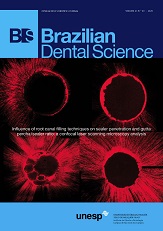Contamination of paper points used by students during preclinical and clinical endodontic procedures
DOI:
https://doi.org/10.14295/bds.2020.v23i3.2055Abstract
Objective: To determine the presence of facultative anaerobic bacteria in the paper points used by students and to perform a pilot test to determine whether sterilization of these materials influences their absorption capacity. Material and Methods: This study consists of two phases. The first is a descriptive phase where a representative sample of paper points (n = 72) was collected from the students and information about the points was voluntarily contributed. The points were placed in saline solution after they were collected, and mechanically shaken for 60 s. Then, 300 IU of the solution was seeded on blood agar in duplicates and incubated for 5 days under anaerobic conditions. The second phase was experimental, during which five paper points of each of the existing sizes were sterilized (Numbers: 15, 20, 25, 30, 35, 40, 45, 50, 55, 60, 70, and 80), and their capacity to absorb water was compared with that of the control or non-sterilized points. Results: The study determined that 22% (n=16) of the points were primarily contaminated by gram-positive bacilli, followed by gram-positive cocci, among which Staphylococcus epidermidis was identified. The presence of contamination was not significantly associated with the conditions of the paper points (p > 0.05). Furthermore, no significant effect (p>0.05) on the absorption capacity of these materials was detected in the sterilization test. Conclusion: Contamination was observed in the paper points used by the students, confirming the importance of implementing sterilization protocols. The sterilization protocols implemented in this study did not affect the absorption capacity of the points.
Keywords
Microbiology, Contamination; Bacteria; Anaerobic.
Downloads
References
World Health Organization. Infection prevention and control. [Internet]. WHO [cited 2019 Feb 12]. Available from: https://www.who.int/antimicrobial-resistance/global-action-plan/infection-prevention-control/en/
Centers for Disease Control and Prevention. Summary of infection prevention practices in dental settings: Basic expectations for safe care [Internet]. Atlanta, GA: Centers for Disease Control and Prevention, US Dept of Health and Human Services; 2016. [cited 2019 Feb 6]. Available from: https://www.cdc.gov/oralhealth/infectioncontrol/pdf/safe-care2.pdf
Malmberg L, Björkner AE, Bergenholtz G. Establishment and maintenance of asepsis in endodontics - a review of the literature. Acta Odontol Scand. 2016;74(6):431–5. doi:10.1080/00016357.2016.1195508
Musani I, Goyal V, Singh A, Bhat C. Evaluation and comparison of biological cleaning efficacy of two endofiles and irrigants as judged by microbial quantification in primary teeth - an in vivo study. Int J Clin Pediatr Dent. 2009;2(3):15–22. doi:10.5005/jp-journals-10005-1013
Sakko M, Tjäderhane L, Rautemaa-Richardson R. Microbiology of root canal infections. Prim Dent J. 2016;5(2):84–9. doi:10.1308/205016816819304231
Aguiar CM, Torres T, Mendes DA, Farias B, Câmara AC. Effect of sterilization methods on the absorption capacity of absorbent paper points. Braz Dent Sci. 2012;15(1):27–32. doi: 10.14295/bds.2012.v15i1.737
Almeida MB, André MC, dos Santos P, de Oliveira T. Avaliação da contaminação de cones de papel absorvente. Rev Bras Odontol. 2010; 67(1):81–5. doi: 10.18363/rbo.v67n1.p.81
Pereira ER, Nabeshima CK, de Lima Machado ME. Analysis of contamination of endodontic absorbent paper points. Rev Odonto Cienc. 2011;26(1):56–60. doi: 10.1590/S1980-65232011000100013
Ximenes R, Marques F, da Silva J, Amaral G, Sassone LM. In vitro analysis of microbial contamination of paper points. RSBO. 2014;11(4):336–9.
Pessoa de Andrade L, Chacon de Oliveira Conde N, Sponchiado Junior EC, Franco Marques AA, Pereira JV, Garcia LF. Contamination of absorbent paper points in clinical practice: a critical approach. Gen Dent. 2014;62(4):e38–e40.
Avendaño A. Verificación de la esterilidad de las puntas de papel absorbente utilizadas en la terapia endodôntica [Internet]. [cited 2019 Jan 15]. Available from:http://www.carlosboveda.com/Odontologosfolder/odontoinvitadoold/odontoinvitado3.htm
do Prado M, Duque TM, Gomes BPFA, Borges DO, Gusman HCS. Evaluation of cell pack paper points: a microbiological study. Dent Press Endod. 2012;2(2):42–6.
Gajan EB, Aghazadeh M, Abashov R, Salem Milani A, Moosavi Z. Microbial flora of root canals of pulpally-infected teeth: enterococcus faecalis a prevalent species. J Dent Res Dent Clin Dent Prospects. 2009;3(1):24–7. doi:10.5681/joddd.2009.007
Shweta, Prakash SK. Dental abscess: a microbiological review. Dent Res J (Isfahan). 2013;10(5):585–91.
Otto M. Staphylococcus epidermidis--the 'accidental' pathogen. Nat Rev Microbiol. 2009;7(8):555–67. doi:10.1038/nrmicro2182
O'Gara JP, Humphreys H. Staphylococcus epidermidis biofilms: importance and implications. J Med Microbiol. 2001;50(7):582–7. doi:10.1099/0022-1317-50-7-582
Otto M. Staphylococcus epidermidis pathogenesis. Methods Mol Biol. 2014;1106:17–31. doi: 10.1007/978-1-62703-736-5_2
Kubo CH, Gomes APM, Jorge AOC. Influência dos métodos de esterilização na capacidade e velocidade de absorção de diferentes marcas comerciais de cones de papel absorvente para endodontia. Rev Odontol UNESP 2000;29(1/2):113-27.
Victorino FR, Lukiantchuk M, Garcia LB, Bramante CM, Moraes IG, Hidalgo MM. Capacidade de absorção e toxicidade de cones de papel após esterilização. RGO. 2008;56(4):411-5.
Downloads
Published
How to Cite
Issue
Section
License
Brazilian Dental Science uses the Creative Commons (CC-BY 4.0) license, thus preserving the integrity of articles in an open access environment. The journal allows the author to retain publishing rights without restrictions.
=================




























